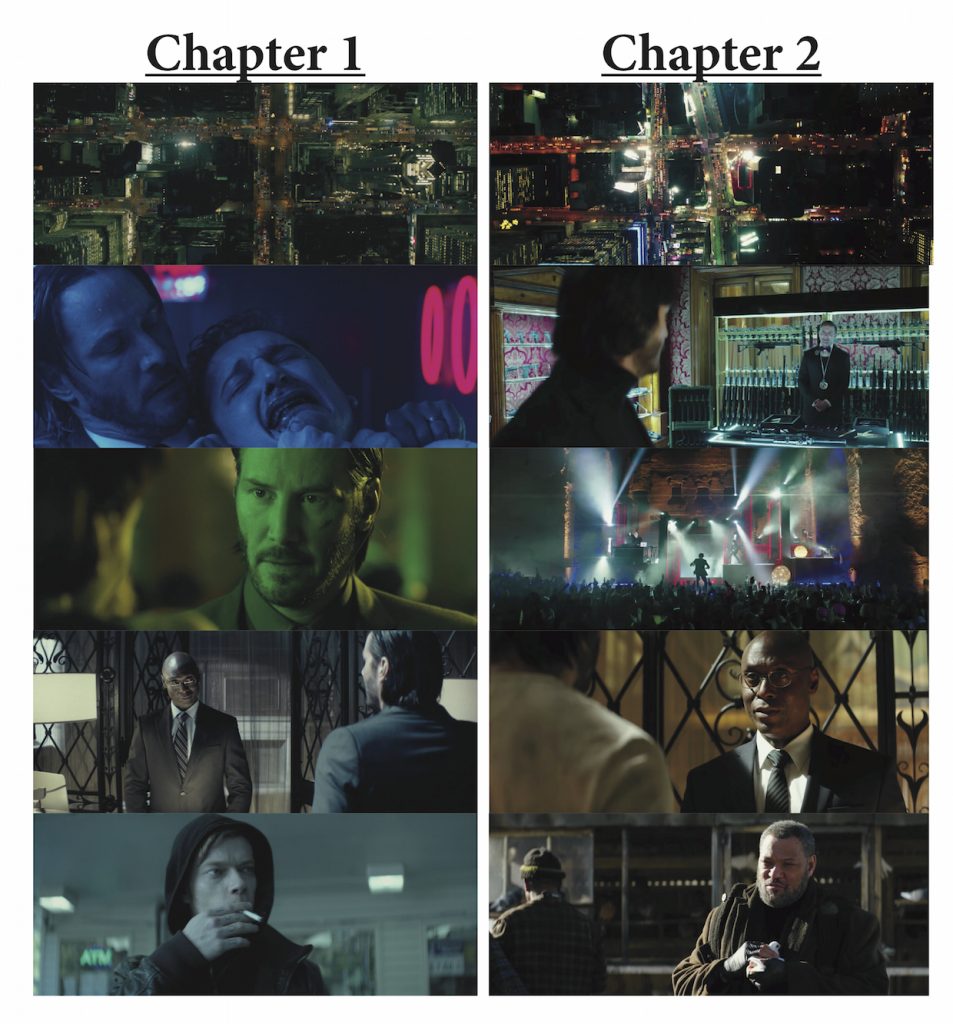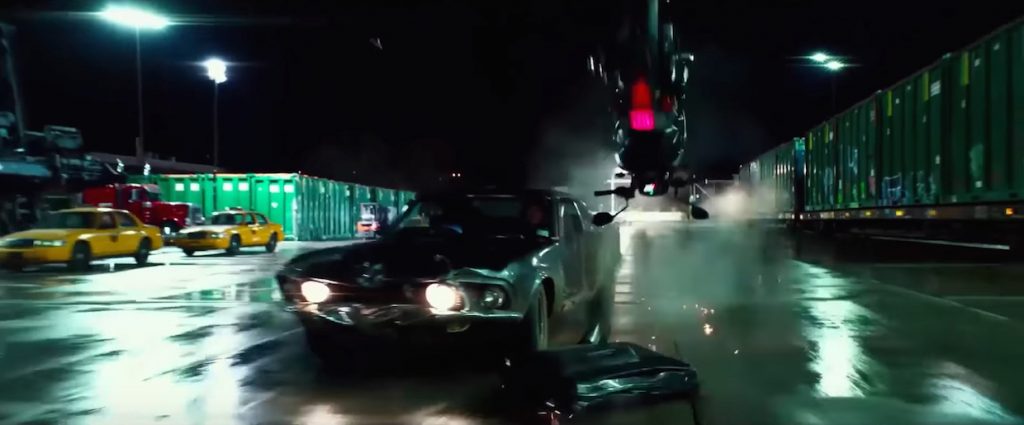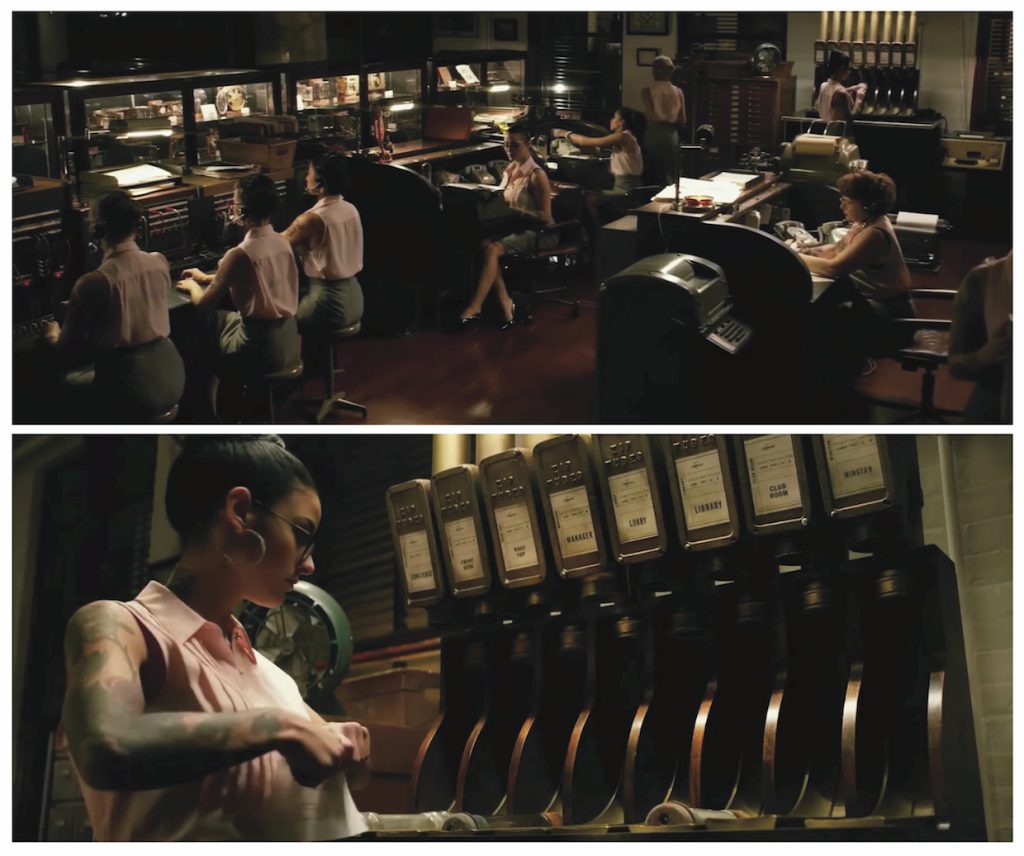 Back to selection
Back to selection
Shutter Angles
Conversations with DPs, directors and below-the-line crew by Matt Mulcahey
“The Bike is Going to Hit the Camera!” Chad Stahelski on John Wick: Chapter 2, Stair Falls and Other Stunts
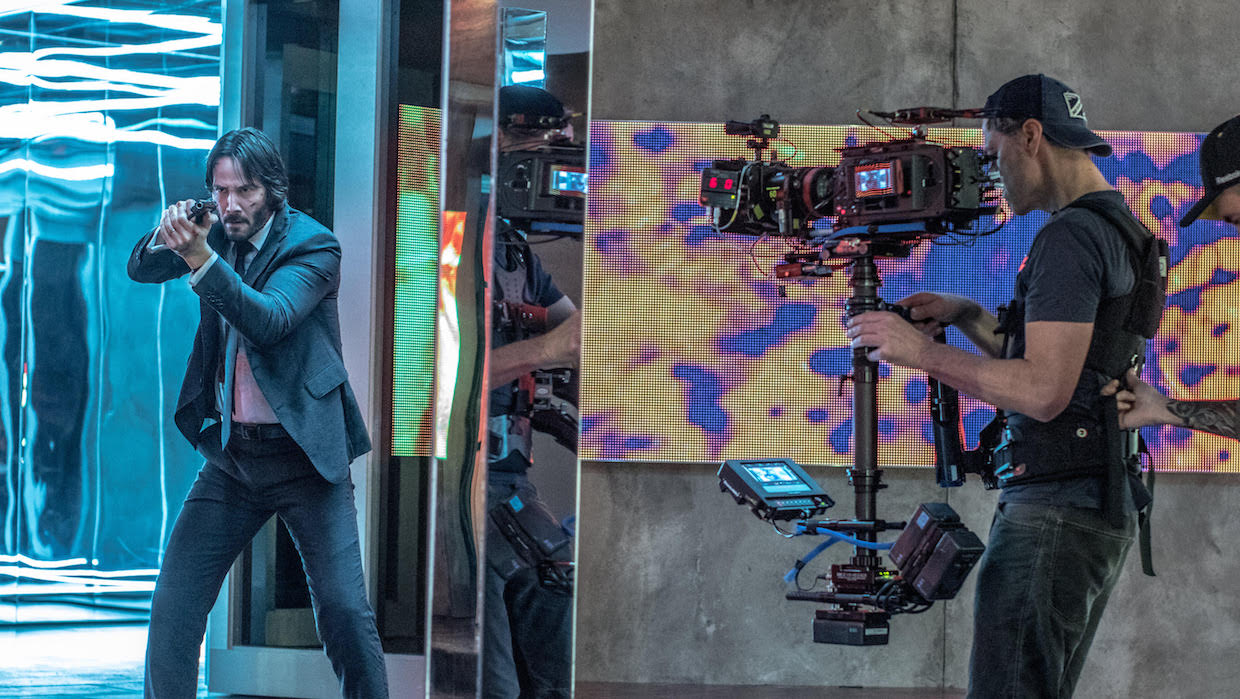 Keanu Reeves on the set of John Wick: Chapter Two (Photo by Niko Tavernise)
Keanu Reeves on the set of John Wick: Chapter Two (Photo by Niko Tavernise) “How can the same shit happen to the same guy twice?” moans John McClane in Die Hard 2. It’s the question at the heart of every high concept action movie sequel. Failing to adequately answer it is how McClane’s New York everyman cop ends up in Moscow, or why half of Bryan Mills’ family gets kidnapped in the Taken series.
Following up John Wick poses a similar conundrum – how do you motivate a retired hitman whose bloody swath of revenge is initiated by the death of his wife and the murder of a cuddly puppy? Do you have his sweet grandmother buy the farm and a gang of thugs bludgeon a baby koala?
John Wick: Chapter 2 circumvents the issue altogether – removing the revenge component from this second offering of stylish tailored suits and balletic “gun fu.” There are detrimental side effects – mainly the absence of the first film’s emotional core– but the shift effectively flips Wick from the hunter to the hunted and provides a reasonable clothesline upon which to drape the film’s phenomenal set pieces. Picking up directly after the conclusion of the original, Chapter 2 finds Wick forced back into action in order to repay a blood oath to an Italian crime lord. After the job’s completion Wick ends up with a contract on his own head – an enticement blasted out to any and all assassins around the globe.
Keanu Reeves is back in the titular role and also returning is director Chad Stahelski, Reeves’ longtime stunt double whose extensive stunt credits include The Crow, The Matrix, and The Expendables in addition to second unit directing duties on The Hunger Games and Captain America: Civil War. With John Wick: Chapter 2 hitting wide release today, Stahelski spoke to Filmmaker about getting hazed on his first ever day on set, why Laurence Fishburne is a director’s dream, and hurling stuntmen into the walls of 2,000 year old Italian catacombs.
Filmmaker: Looking over your long list of credits, the first things listed are a couple of movies as a stuntman in the early 1990s for Albert Pyun (director of Cyborg, The Sword and the Sorcerer, and a hundred other B action movies).
Stahelski: Albert is the only guy I know who can shoot a whole movie in ten days. He was a very generous human being and those movies basically helped me pay my bills for my first two years in the business. I owe a lot to Albert. He’s a great guy.
Filmmaker: Do you have a favorite story from those movies?
Stahelski: It would be from the first movie I did with Albert, Knights. That’s where I got my SAG card. I had never been on a set before and the first day at lunch the older stunt guys thought they would fuck with me a little bit. We were way out in the desert in Moab and I was standing in line for lunch in full wardrobe dressed like a cyborg. When you’re on set you don’t carry your personal effects so I didn’t have my wallet. The two stunt guys in front of me started patting their pockets and going, “Hey, do you have your wallet so we can pay for lunch?” And I was so embarrassed that I didn’t have any money on me that I just excused myself and went and ate off of the craft service table. They let me go the whole day thinking you had to pay for your lunch on set. (laughs)
Filmmaker: Let’s jump on into John Wick: Chapter 2. You’ve got a new cinematographer this time around in Dan Laustsen. I love his work on Brotherhood of the Wolf and Crimson Peak.
Stahelski: I love Brotherhood of the Wolf too. Mark Dacascos is fantastic in that movie. On the first [John Wick] our DP Jonathan Sela did a great job for us, but my partner David Leitch was doing a Charlize Theron movie called The Coldest City so we had to divide up [the crew we’d been working with]. Because Jonathan and David had an established relationship before I had met Jonathan, he went to work with David on The Coldest City.
Dan Laustsen had always been on our radar — even for the first film — but we thought he was somebody who was way beyond what we were capable of financially supporting on the first one. So when it came time for Chapter 2 the list [of potential DPs] was very, very short and it wasn’t necessarily based on who had the biggest credits, but rather who we thought could create a world. I had pitched the idea to a couple of other cinematographers about the fight scene in the mirror room, what I wanted to do with color in the catacombs shootout, and this idea of doing longer takes, and you can always tell who’s the right guy by who does not roll their eyes back in their head, like “What are you thinking?” And when I mentioned the mirror room to Dan, without missing a beat, he started adding ideas — “We can use these colors and we’ll have video monitors and on and on.”
(Above – click to enlarge) A comparison between the looks of John Wick Chapters 1 and 2. The first installment was shot partially with Hawk V-Lite Vintage ’74 anamorphic lenses, which soften the image and reduce contrast. Chapter 2 was shot largely with Zeiss Master Anamorphics, which are sharper and have more contrast.
Filmmaker: The way that you cover the fight scenes with these longer takes and wider frames is similar to the first film, but the actual look of Chapter 2 is significantly different.
Stahelski: That was the plan. We tried to separate the two movies as much as we could. One of the things we wanted to do is a lot of in-camera lighting. Because I wanted to compose everything in very wide frames, Dan had to either hide the lights or embrace those wide frames and put the lights into the shot. That’s why you see these LED strips in so many shots and that’s why you see the sources in the scenes in the catacombs and the concert in Rome. I’ve also always wanted to do a lot with color in an action film. Christopher Nolan does a great job with really dark action, but without meaning to sound derogatory I think a lot of other people who have tried to do that have missed the mark a little bit and have been too dark and too gritty. We wanted to put color back into the action.
Filmmaker: There’s not a crazy amount of coverage in the action scenes. How many cameras did you typically have going?
Stahelski: We always carried three but we usually only shot with two. I’ve been on sets where they use four cameras or five cameras and everybody’s bumping into each other. They think, “It’s an action sequence so we’ll just shoot it with as many cameras as we can and then we’ll piece it together later.” I think quality far outweighs quantity. On our car days we would carry a few more cameras just for ease of placement, but the biggest car crashes and the biggest stunts in the movie still only had at most three cameras rolling.
Filmmaker: Tell me about this stunt during the opening action sequence where John Wick opens his car door and takes out a motorcycle-riding henchman – the rider goes flying, the car door comes off, and the motorcycle barrels toward the camera. It unfolds in an unbroken take, shot from a picture vehicle in front of Wick’s car. What are the pieces needed to make a shot like that work?
Stahelski: Honestly it just comes down to having really good people. We got the best Russian Arm camera car driver, a guy named Allan Padelford. So he’s operating the vehicle with a monitor where the windshield should be so he can tell where everything is going. [After the crash], as the motorcycle got closer and closer to the camera, Allan stepped on the gas while still managing to keep everything in frame. But as you watched it from where I was standing by the monitors it was like, “Oh shit, oh shit, oh shit, the bike is going to hit the camera!”
Filmmaker: With a gag like that how many chances do you really have to get it right? It’s not like you have an infinite number of motorcycles to crash or car doors to break off.
Stahelski: We did two takes and the second take is what’s in the movie.
Filmmaker: Was the second take just for safety or did something go wrong on the first take?
Stahelski: In the first take the bike didn’t quite do what we wanted. When you really crash things it’s not like in the movies. They do odd things. On the first take the bike didn’t slide like we wanted it to slide. It kind of hit and slid off away from the camera instead of toward the camera. So we adjusted a few little things and did a second take.
Filmmaker: There are a lot less moving parts in the next stunt I want to ask about — the wide shot of Wick and fellow hitman Cassian (played by Common – or for this shot Common’s stunt double) rolling down these long concrete steps in Rome.
Stahelski: Jackson Spidell and Danny Graham are the stunt guys that did that. I was scouting one day in Rome and I was with my production designer and location scout and we walked by those stairs and went “Whoa! That is quite the stair fall. That would suck (to tumble down those)…It’s perfect.” Anybody that’s done a stair fall — not that a lot of people have (laughs) — but anybody who has done a stair fall knows that if you hold back you’re probably going to get injured. The best way to do it is just say “Fuck it, we’re going to go big.” I wanted to do it with as few cuts as possible so I put a camera way at the bottom of these three different sections of stairs and I told the stunt guys, “No matter what you do, make it down to the bottom.” So in the movie you watch them fall in a shot from the top of the stairs and then we cut to the camera at the bottom of the stairs and you see them roll and make it to the first landing. Then they pick each other up and continue to fight and throw each other down the second set of stairs. On the day you could actually hear Jackson talking to Danny saying, “Get up motherfucker, we’re not stopping.” Every time we were editing that scene we’d turn up the sound and laugh at that. My editor Evan Schiff thought it was the funniest thing he’d ever heard so we left it in the movie. So when you hear this voice going, “Come on fucker, let’s go.” That’s actually our stunt guys talking to each other, being like “Don’t you dare stop because I ain’t doing this again.”
Filmmaker: How do you handle working with guns in such close proximity to actors? I’m assuming the muzzle flashes and the blood spatter are added in post, but can you do any sort of blanks when the guns are that close to actors’ faces? How do you get a realistic recoil?
Stahelski: From a choreography standpoint I knew I wanted to shoot wide and have cause and effect in the same shot, as opposed to a shot of a gun firing and then a reverse of the guy getting hit. I think those edits take away from the vitality of a gunfight and the pacing of a gunfight. Most of the time when you use prop guns they’re basically real guns with blanks in them and the effective safe distance is usually anywhere from 15 to 25 feet, which is too far for our “gun fu.” So we went back and worked with the prop guys and gunsmiths and came up with a solid barrel gun — meaning nothing can be ejected, no debris, no dirt, no muzzle flash — but the gun still cycles. So the slide still moves, it still ejects a casing, and there’s actually a little spark that comes out the side and we just digitally took those out and then put in our muzzle flashes. Then the choreography involves quite a bit of work, with Keanu getting out there and doing tons and tons of live firing to get used to the recoil and how to brace himself and then how to time the jiu-jitsu, the judo, and the other martial arts styles we use to make it a very elegant combat style that looks brutal but still dance-like.
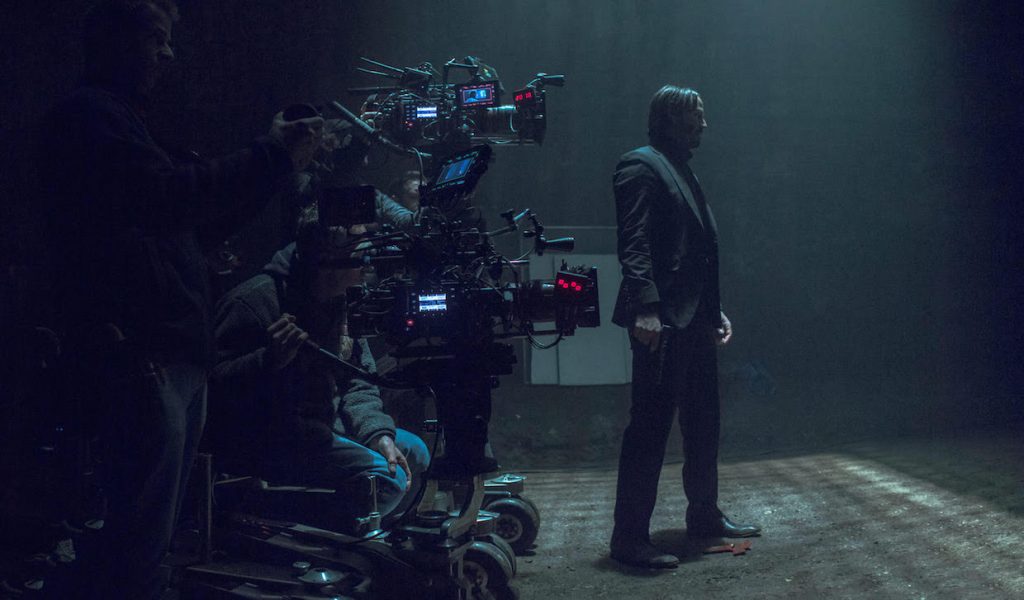
Filmmaker: The middle section of the film is set in Rome, where Wick goes for a hit that takes him to a concert inside ancient ruins. While escaping after the assassination, Wick ends up in a shootout in these catacombs beneath the ruins. What is that location?
Stahelski: That was one of the first places I scouted in Rome. It’s called Caracalla. It’s a 2,000 year old Roman bath house. The above ground portion is exactly the way you see it in the movie. We just built the concert stage right in the middle of the Caracalla ruins. Then directly underneath that stage is the actual catacombs. So those two location are practically tied together. On top of that they let me bring in 100 stunt guys and let me shoot them. It was funny, the lady [in charge of the facility] walked me down to the catacombs and I asked, “Can I shoot people down here?” And she said, “Oh sure.” And I said, “Really? Stunt guys are going to be hitting the walls.” And she smacked the wall and said, “They’ve been here 2,000 years. Don’t worry about it.” (laughs)
Filmmaker: One aspect of John Wick that lends itself to sequels is the world building you do with the Continental hotel and its hidden realm of contract killers. In Chapter 2 you add an underground army led by Laurence Fishburne. Is that Fishburne line about going to Applebee’s an improv?
Stahelski: (laughs) Complete improv. Laurence is a pretty funny guy. That was the most extreme take of that scene. Laurence is great to work with. He knows when to ramp it up and he knows when to use that great voice. There were five or six takes of that before where he was very reserved. After those takes he was like, “What else would you like?” And I said, “Let’s try one that’s a little bit more operatic. I want this guy to be larger than life. Go big.” And he was like, “You want big? Watch this.” He’s a director’s dream. He gives you so many options.
Filmmaker: Another new detail I enjoyed is the telephone switchboard room in the Continental, where people call in to take out a contract. Where did that idea evolve from?
Stahelski: Being in the movie business you’re always on location and you’re basically living in hotels. I get bored in hotels, so I’ll go walk around and walk through the kitchen or I’ll talk to the manager. One time I was in this very old hotel in London that actually had a switchboard. They didn’t use it anymore but it was still there — with the tubes, the whole deal. And I was like, “I’m going to use this in a movie someday.”
Matt Mulcahey writes about film on his blog Deep Fried Movies.
